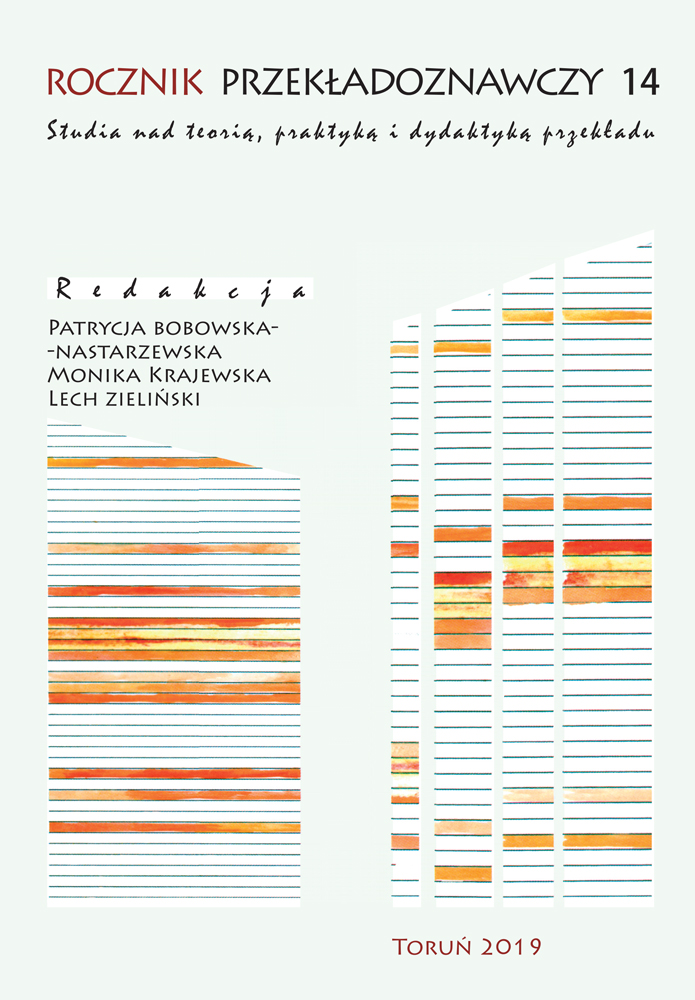Neuronas espejo y anticipación en interpretación simultanea
DOI:
https://doi.org/10.12775/RP.2019.005Słowa kluczowe
antycypacja, neurony lustrzane, tłumaczenie symultaniczneAbstrakt
Antycypacja to częste zjawisko w tłumaczeniu symultanicznym, a przez część badaczy (Gile, 1995; Chernov 1994, 2004) postrzegana jest jako konieczna z uwagi na syntaktyczne różnice strukturalne w parze językowej, w której pracuje tłumacz. Stoimy na stanowisku, że antycypacja nie może być uważana za strategię, którą tłumacz niejako włącza lub wyłącza w tłumaczeniu. Antycypacja stanowi podstawę reformulacji- jeśli tłumacz nie jest w stanie przewidzieć znaczenia wypowiedzi przed jej zakończeniem, bardzo trudno jest dokonać reorganizacji lub zreformułowania wypowiedzi i oddać w tłumaczeniu słowa, składnię czy znaczenie. W badaniach przekładoznawczych od stosunkowo niedawna pojawiły się nowe pola takie jak psycholingwistyka czy kognitywistyka (Ferreira, A. & Schwieter, J.W., 2015); mogą one rzucić nowe światło na procesy występujące w tłumaczeniu ustnym. W tym miejscu warto wspomnieć o roli, którą odgrywają neurony lustrzane (Rizzolatti et al. 1996), a które mogą służyć wyjaśnieniu zagadnienia, dlaczego w komunikacji - a takowa jest tłumaczenie symultaniczne – zachodzi ciągły i naturalny proces antycypacji.
Bibliografia
Alves F., 2015, Translation Process Research at the Interface. Paradigmatic, Theoretical, and Methodological Issues in Dialogue with Cognitive Science, Expertise Studies, and Psycholinguistics, [in:] Psycholinguistic and Cognitive Inquiries into Translation and Interpreting, A. Ferreira, J. W. Schwieter (eds.), Amsterdam–Philadelphia, pp. 17–40.
Bartłomiejczyk M., 2008, Anticipation: A Controversial Interpreting Strategy, [in:] Translation and Meaning Part 8, M. Thelen, B. Lewandowska- -Tomaszczyk (eds.), Maastricht, pp. 117–126.
Besien F. van, 1999, Anticipation in Simultaneous Interpreting, “Meta”, Vol. 44(2), pp. 250–259.
Becchio C., Manera V., Sartori L., Cavallo A., Castiello U., 2012, Grasping intentions: From thought experiments to empirical evidence, “Front Hum Neurosci”, Vol. 6, https://www.ncbi.nlm.nih.gov/pmc/articles/ PMC3340947/ (access: 8.01.2019).
Binkofski F. et al., 1999, A Fronto-Parietal Circuit for Object Manipulation in Man: Evidence from an fMRI-Study, [in:] Mirror Neurons and the Evolution of Brain and Language, Amsterdam–Philadelphia, pp. 37–59.
Chernov G. V., 1979, Semantic Aspects of Psycholinguistic Research in Simultaneous Interpretation, “Language and Speech”, Vol. 22(3), pp. 277–295.
Chernov G. V., 1981, “Semantic Redundancy as a Key to Reliable Comprehension of a Verbal Message (Objective and Subjective Factors)”, [in:] Comprehendre le Langage: Actes du Colloque International et Multidisciplinaire sur la Comprehension du Langage, Didier Collection “Linguistique” no 12, Paris, pp. 31–37.
Decety J., 2001, “Is there such a Thing as Functional Equivalence between Imagined, Observed, and Executed Action?”, [in:] The imitative Mind. Development, Evolution, and Brain Bases, A. N. Meltzoff, W. Prinz (eds.), Cambridge University Press, Cambridge–New York–Melbourne–Madrid–Cape Town–Singapore–Sao Paulo, pp. 291–310.
Ericsson K. A., 2000, Expertise in Interpreting, “Interpreting”, Vol. 5(2), pp. 187–220.
Ferreira A., Schwieter J. W. (eds.), 2015, Psycholinguistic and Cognitive Inquiries into Translation and Interpreting, Amsterdam–Philadelphia.
Gile D., 2015, “The Contributions of Cognitive Psychology and Psycholinguistics To Conference Interpreting. A Critical Analysis”, [in:] Psycholinguistic and Cognitive Inquiries into Translation and Interpreting, A. Ferreira, J. W. Schwieter (eds.), Amsterdam–Philadelphia, pp. 41–64.
Gillies A., 2013, Conference Interpreting. A Student’s Practice Book, New York.
Hild A., 2015, “Discourse Comprehension in Simultaneous Interpreting. The role of Expertise and Information Redundancy”, [in:] Psycholinguistic and Cognitive Inquiries into Translation and Interpreting, A. Ferreira, J. W. Schwieter (eds.), Amsterdam–Philadelphia, pp. 67–100.
Jones R., 1998, Conference Interpreting Explained, St. Jerome Publishing, Manchester.
Kohn K. & Kalina S., 1996, The Strategic Dimension of Interpreting, “Meta”, Vol. 41(1), pp. 118–138.
LeDoux J., 1998, The Emotional Brain, [in:] Mirror Neurons and the Evolution of Brain and Language, V. Gallese, M.I. Stamenov (eds.), Amsterdam– Philadelphia, pp. 333–340.
Li C.N. & Hombert J. M., 2002, On the Evolutionary Origin of Language, [in:] Mirror Neurons and the Evolution of Brain and Language, V. Gallese, M. I. Stamenov (eds.), Amsterdam–Philadelphia, pp. 175–205.
Lintou K., 2015, Anticipation, [in:] Routledge Encyclopedia of Interpreting Studies, F. Pochhacker (ed.), London, pp. 15–16.
Manera V. et al., 2013, Time will show: Real Time Prediction during Interpersonal Action Perception, “PLOS ONE”, Vol. 1: e54949, pp. 1–6.
Meltzoff N. & Prinz W. (eds.), 2001, The imitative Mind. Development, Evolution, and Brain Bases, Cambridge–New York–Melbourne–Madrid–Cape Town–Singapo –Sao Paulo.
Morrison I., 2002, Mirror Neurons and Cultural Transmission, [in:] Mirror Neurons and the Evolution of Brain and Language, V. Gallese, M. I. Stamenov (eds.), Amsterdam–Philadelphia, pp. 333–340.
Rizzolatti G. et al., 2001, From Mirror Neurons to Imitation: Facts and Speculations, [in:] The imitative Mind. Development, Evolution, and Brain Bases, A. N. Meltzoff, W. Prinz (eds.), Cambridge University Press, Cambridge – New York – Melbourne – Madrid – Cape Town – Singapore – Sao Paulo, pp. 247–290.
Rizzolatti G. et al., 2002, The Mirror System in Humans, [in:] Mirror Neurons and the Evolution of Brain and Language, V. Gallese, M. I. Stamenov (eds.), Amsterdam–Philadelphia, pp. 37–59.
Sebanz N., Knoblich G. (2009), Prediction in Joint Action: What, When, and Where, “Topics in Cognitive Science”, Vol. 1(2), pp. 353–367.
Stamenov M. I. & Gallese V. (eds.), 2002, Mirror Neurons and the Evolution of Brain and Language, Amsterdam–Philadelphia.
Womble S., & Wermter S., 2002, Mirror Neurons and Feedback Learning, [in:] Mirror Neurons and the Evolution of Brain and Language, V. Gallese, M. I. Stamenov (eds.), Amsterdam–Philadelphia, pp. 353–362.
Pobrania
Opublikowane
Numer
Dział
Statystyki
Liczba wyświetleń i pobrań: 1634
Liczba cytowań: 0



